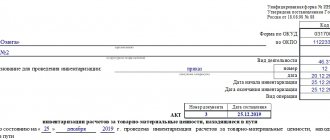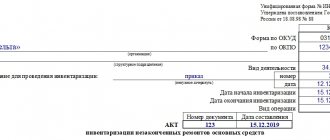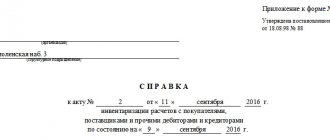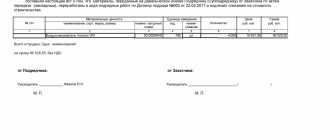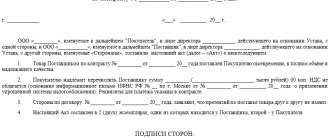Carrying out a full or partial inventory of inventory items (TMV), the commission identifies a group of goods, materials and products that have already been shipped to the buyer, but have not yet been paid for. During the inspection, an inventory report INV-4 is drawn up.
The inventory assets of the enterprise include: finished products, raw materials, goods, surplus production, while the INV-3 inventory form is filled out and goods shipped by the customer for which payment has not yet been made are not taken into account. A separate INV-4 act is filled out for this group of goods. If goods are accepted for storage, then the basic information is reflected in the inventory report INV-5. All inventory items that are on the route are reflected by the inventory commission in the INV-6 form.
If goods and materials have already been shipped, but not paid, or payment has not been received on time, then the INV-4 act is filled out. All other documents are also filled out by the inventory commission, which is approved by a special order for conducting scheduled (unscheduled) inventories. There will be 2 forms in total: one is given to the accounting department, the other is sent to the financially responsible person.
When is INV-4 needed?
The form is used to inventory two types of inventory items. The first is goods and materials shipped that were not paid for on time. The second is those that have been shipped, but payment for them has not yet been made under the terms of the agreement between the counterparties. The first and second types must be issued on separate forms.
All inventory items for which information is indicated in the act must be accounted for on account 45 of the chart of accounts.
Reference! Inventory and materials at an enterprise or company include goods, finished products, materials, surplus production, work in progress, etc.
When is an inventory report drawn up?
Many managers assume that they have the right to conduct or not conduct an inventory at their own discretion. This is not entirely true. In accordance with the norms of the current legislation of the Russian Federation, such a procedure is mandatory in the following cases:
- before drawing up annual financial statements, while an inventory of fixed assets can be carried out once every 3 years, library collections - once every 5 years
- when an organization transfers property for rent, redemption, sale
- when changing financially responsible persons (dismissal, transfer, etc.)
- identification of facts of theft, abuse or damage to property
- during reorganization (change of organizational and legal form) or liquidation of the organization
- in case of fire, natural disaster and other emergency situations
- if the organization has introduced collective (team) responsibility, then an inventory must be carried out when the leader of such a team changes, when more than 50% of its members leave the team, at the request of one or more members.
In addition to these cases, inventory is carried out by decision of the manager. The purpose of the event is to identify the actual availability of property and compare it with accounting data. At the same time, when there is a change of financially responsible persons, in addition to the Inventory Report, an act of acceptance and transfer of entrusted property is drawn up.
What property is subject to inventory? Fixed assets, financial investments, finished products, goods, intangible assets, cash and other financial assets, loans, borrowings and reserves.
Responsible persons who are directly involved in the inspection draw up all related documents. The main one is the inventory act. All scan data, its features and results are displayed here. It is worth noting that the type of verification performed determines the type of unified form required for a particular situation.
In essence, this document officially confirms what assets are available on the organization’s balance sheet. All assets of the organization are subject to inspection. After all, this is the only way to find out whether the reporting documents correspond to reality. There are situations in which verification must be carried out without fail. For example, it must be carried out before preparing the report at the end of the year. The law also requires that an inventory be taken during the reorganization or complete liquidation of a company. These actions are also carried out in cases where new employees take the position of director or financially responsible employee.
In addition, the act is drawn up in the following situations:
- The company rents or sells property;
- There are suspicions of theft and damage to property;
- After fires, disasters and other force majeure events;
- In any situation where the head of the company deems it necessary to conduct an inspection.
Does a company have to work with INV-4?
Form INV-4 unified, primary document. The form was introduced by Resolution of the State Statistics Committee of August 18, 1998 No. 88. INV-4 was mandatory until 2013, and then the mandatory unified forms became recommended. To take inventory of shipped goods and materials, organizations have the right to draw up their own form, supplementing the existing one. Mandatory details cannot be removed from the form; without them, the document will not be considered legally significant.
The convenience of INV-4 is undeniable: some companies still use it. In addition, inspection authorities also prefer to work with unified papers.
Attention! The company's management must decide in favor of its own developed or unified forms and record it in the accounting policies.
What assets (values) are inventoried
Each type of value requires the drawing up of an act of the appropriate form. This is described in paragraph 1.2 of the Resolution of the State Statistics Committee of August 18, 1998. So, they distinguish:
- Fixed assets. The act will be drawn up in the INV-1 form.
- Goods. INV-3.
- Intangible assets. Trademarks, programs, etc. INV-1a.
- Materials, individual elements of goods.
- Money. Both in cash and placed in bank deposit accounts.
- Debt content of the institution.
An appointed financially responsible person (MRP) is responsible for each unit subject to inspection. Typically, an employee assumes financial responsibility by applying for a job and concluding an appropriate contract.
Fundamentally important! Information about the actual condition of material and other assets is entered into the act in at least 2 copies.
Members of the commission can use all available methods (specified in the Methodological Recommendations) that provide information about the objects being inspected, their quantity and quality.
Briefly about the commission
To conduct any inventory in an organization, a commission must be convened. It can be approved once indefinitely or each time before an inspection by order of the head (Order of the Ministry of Finance of the Russian Federation dated June 13, 1995 No. 49). The quantitative composition is not fixed by law anywhere. Usually it is 3-4 people and a chairman. The composition must necessarily include employees of the accounting department and administration of the company. They also usually include a lawyer, department heads, economist, etc.
The entire composition of the commission must participate in the inventory. If one of its members is not present and his signature is not on the document, then the inventory and the papers on it will be considered invalid.
Important! Financially responsible employees cannot be included in the commission.
The procedure for carrying out inventory in the Russian Federation
Before starting the inventory, which will be carried out in anticipation of the annual reporting, it is necessary to take care of the correct execution of all necessary documents. Thus, the verification process can be divided into stages:
- Issuance of an order. The manager must create a written document, which will become the basis for the inspection. A unified form is used for this. Information about the inspectors, property, and inspection deadlines is provided here in detail. The date by which the commission is obliged to carry out all actions related to the inventory is also indicated.
- Typically, the commission includes accounting employees, managers of individual departments, technologists, and economists. It could also be other specialists. As a rule, the head of the department is appointed senior. The inspectors must be accompanied by a financially responsible employee.
- Before the inspection, the responsible employee gives a receipt, which will indicate that all incoming and outgoing documents processed over a certain period are correctly compiled and submitted to the accounting department. The receipt also states that the materials were written off according to the law.
- All measuring instruments that will be used are also checked. The balances that are listed in the accounting department are determined. Specialists record the available documentation before the inspection begins.
- The check itself consists of weighings, recalculations, and measurements. When inspectors take a break, the property must remain secured or locked.
- Preparation of matching statements. This allows discrepancies to be identified. After the inventory, a protocol is drawn up where the commission’s findings are entered.
Fill out the INV-4 form
The form is filled out on the front and back sides. We will describe each in detail below.
Front side
First of all, you need to fill out information about the organization, inventory and the document itself:
- name of the company, its structural division;
- OKPO code;
- Kind of activity;
- name and details of the document (number, date of creation) on the basis of which the procedure is carried out;
- inventory start and end dates;
- type of operation;
- accounting account number;
- number and date of preparation of the current document.
Then a table begins where you need to enter the following information:
- Serial number of the record.
- Name of the purchasing organization and its OKPO code.
- Name and type of inventory items.
- Nomenclature number of goods and materials.
- The name of the unit of measurement and its OKEI code.
- Date of shipment of goods and materials.
- Name of goods and materials, date of shipment, number, quantity and amount according to information from commodity transport or settlement papers.
- Quantity and amount according to accounting information.
- Note.
At the end, the “Total” column is filled in according to the data on the page.
Reverse side
The table continues here. It is filled out in the same way. At the end of the table, they summarize the page and the act as a whole.
Next, indicate in words the total amount of inventory and materials according to the data of commodity-transport or settlement and payment papers.
At the end of the document, the members and the chairman of the commission sign.
Conditions for conducting inventory in 2021
In order for responsible employees to begin carrying out the inventory, a corresponding order must be issued from the director. The manager also appoints employees who are part of the inspection team. You need to know that the inspection is carried out exclusively in the presence of the financially responsible employee.
Next, the commission proceeds directly to the inspection. It includes various actions: taking measurements, counting, weighing. Inspectors make sure that the property is actually in its place. All information is entered into the act, which is then compared with the reports of the accounting department. With simple calculations, you can identify whether there are discrepancies. If there are any, responsible employees find out the reasons.
The last stage of verification is the correct recording of its results. If deficiencies and discrepancies are found, an investigation begins to identify those responsible. As a rule, these are the persons responsible for the property. Responsible employees face administrative punishment.
What else is important to know about the document
- Information can be entered into the act by hand or on a computer. If the version is handwritten, then blots are not allowed.
- The act in form INV-4 must be drawn up in 2 copies. One is sent to the accountant, and the other remains with the financially responsible person.
- If a factual error has already been found in the completed act, it must be corrected. In this case, the fact is communicated to all persons participating in the inventory. The fragment with an error is crossed out, and the correct version is placed on top or next to it. Then all commission members put their signatures.
- It is necessary to keep the inventory report of shipped inventory items for 5 years.
Inventory forms
Inventory forms are something that no inventory can do without, carried out according to the rules and modern standards, and each stage of its implementation has its own form with its own approved document form.
Approved forms of documents related to the inventory: acts and inventory forms, inventory, statements and samples of other documents
Note: all forms and inventory reports presented in this section are approved by Resolution of the State Statistics Committee of the Russian Federation dated August 18, 1998 N 88
| Shape index | Document Format | Name |
| Form INV-1 | inventory | Inventory list of fixed assets |
| Form INV-1a | inventory | Inventory list of intangible assets |
| Form INV-2 | label | Inventory label |
| Form INV-3 | inventory | Inventory list of inventory items |
| Form INV-4 | Act | Inventory report of shipped inventory items |
| Form INV-5 | inventory | Inventory list of inventory items accepted for safekeeping |
| Form INV-6 | Act | Act of inventory of inventory items in transit |
| Form INV-8 | Act | Inventory act of precious metals and products made from them |
| Form INV-8a | inventory | Inventory inventory of precious metals contained in parts, semi-finished products, assembly units (assemblies), equipment, instruments and other products |
| Form INV-9 | Act | Act of inventory of precious stones, natural diamonds and products made from them |
| Form INV-10 | Act | Inventory report of unfinished repairs of fixed assets |
| Form INV-11 | Act | Act of inventory of future expenses |
| Form INV-15 | Act | Cash inventory report |
| Form INV-16 | inventory | Inventory list of securities and forms of strict reporting documents |
| Form INV-17 | Act | Act of inventory of settlements with buyers, suppliers and other debtors and creditors |
| Form INV-18 | statement | Comparison statement of the results of inventory of fixed assets |
| Form INV-19 | statement | Comparison sheet of inventory inventory results |
| Form INV-22 | order | Order (decree, order) to conduct an inventory |
| Form INV-23 | magazine | Logbook for monitoring the implementation of orders (decrees, instructions) on inventory |
| Form INV-24 | Act | Act on the control check of the correctness of the inventory of valuables |
| Form INV-25 | magazine | Logbook for control checks of the correctness of inventories |
Why is it necessary?
An inventory act is necessary for control and accounting of inventory items, cash, intangible assets, and the correctness of settlements with creditors and debtors. Inventory is used to compare the actual availability of valuables with the quantity recorded in the documents
The state does not provide for fines for non-compliance with control measures for private entrepreneurs. Therefore, entrepreneurs do not always conduct such checks at their enterprises. But if you want to ensure that material assets are stored and used properly, do not forget about inventory.
How to draw up an inventory report
The procedure is carried out by decision of the head of the commission, the composition of which is necessarily approved by order. Moreover, the composition of such a commission, as a rule, is permanent. It includes representatives of the organization’s administration, accounting, economists, technicians, etc., incl. It is possible to involve independent audit organizations. The absence of at least one member of the commission during the inventory may be grounds to invalidate its results.
Depending on the purpose of the inventory, whether it is planned or unplanned, inventory acts can have different forms and contents:
- cash inventory act,
- act of inventory of goods shipped, etc.
The form of each such act of approval by order of the Ministry of Finance of the Russian Federation. These forms are approximate, but very convenient for use.
The inventory report is drawn up in at least 2 copies; no erasures, corrections or blots are allowed. The actual availability of property is carried out exclusively with the participation of financially responsible persons, from whom explanations may be requested during the procedure.
The document must be signed by all members of the commission and the financially responsible person, who at the end of the inventory report gives a receipt indicating that there are no claims against the members of the commission.
Documentation of inspection results
Naturally, the fact of verification must be documented. For these purposes, orders, acts, accounting journals, inventories, and collating documents are drawn up. All documents prepared during the inventory process must have at least two copies.
There are many standardized forms used for specific situations. They should indicate the following information:
- Company name;
- Title of the document;
- description of objects subject to inventory;
- indication of measurement units, cost and quantity;
- inspectors, their positions and signatures with transcripts.
The legislation does not prohibit adding any new items to the unified form, or changing existing ones. However, you need to remember that the listed points must be left unchanged.
Passage mechanism
It all starts with the manager’s order (INV-22 form) to begin this procedure. A commission is selected. It can consist of both the heads of the institution and external auditors or ordinary company employees, specialists in measuring something, etc.
Each financially responsible person first draws up a receipt stating that the material assets under his control are classified and then written off or capitalized (and transferred for inventory). Employees do this in accordance with clause 2.4 of Order of the Ministry of Finance dated June 13, 1995 No. 49.
The commission begins the process on the appointed day. All persons listed in the order must be present, otherwise the entire event may be declared invalid with all the ensuing consequences.
Related documents
The paper will not be valid without:
- An order from management to begin forming a commission. It details the inspection objects, date (or start and end dates), location and persons involved.
- Inventory list. Details for each position will never be superfluous.
- Comparison statement. It is a kind of annex to the previous document.
Who is it approved by, where is it registered?
In addition to the signature of the commission, the act must be “secured” with his signature by the head of the organization. The order, which contains a list of commission members, must be entered in a special book for monitoring the implementation of orders of the institution.
If the institution has a small staff and a small amount of material and other assets involved in the activities, then the use of an audit commission present is allowed.
Objects to be checked
All property that is on the organization’s balance sheet is subject to inventory:
- financial investments;
- fixed assets;
- intangible assets;
- raw materials and finished products;
- inventories held for production;
- various financial assets;
- money, both cash and non-cash.
The financial obligations of the organization are also checked. These can be credits, debts, loans, etc. Naturally, all this must be accompanied by appropriate agreements, which allow for a correct inventory.
There are situations when a check is carried out for a specific department. However, a complete inventory, which is usually carried out at the end of the year, will require maximum effort. Its data is used in the preparation of annual reports. It is this type of check that brings together absolutely everything that may be on the company’s balance sheet.
A complete inventory allows you not only to determine the actual availability of property, but also to check how correctly it is displayed in accounting documents. In addition, the commission makes sure that the equipment is used correctly and the raw materials are stored, and checks how correctly the property is treated. If necessary, certain comments are indicated.
Changes to the document
Errors may be made when conducting an inventory. If errors have crept into the documents, they must be corrected. Corrections are made according to the following scheme:
- Notify all members of the commission about the error and the need to correct it.
- Cross out the erroneous text with one line.
- Correct information is written next to or above the erroneous text with a ballpoint pen.
- Signatures are taken from all members of the commission. They must confirm their agreement with the corrections with a wet signature.
It is advisable not to make mistakes when filling out the inventory report. If an error is detected at the stage of filling out the printed form, the document is rewritten and only then signed by the commission. The erroneous act is destroyed.
Control
Inventory itself is a form of control. But after its completion, it is possible to carry out control checks of the correctness of the inventory. The number of participants can only expand.
You can begin such a check strictly before the seals on the premises where the initial accounting of resources was carried out are broken.
The results of special control checks are drawn up in the form of a control check of the correctness of the process (form INV-24) and are subject to registration in the book of control checks of the correctness of the process.
Also, in large institutions, unscheduled events may be carried out related to selective accounting of material assets. As for the timing, the inspection is carried out at any time at the discretion of the manager.
